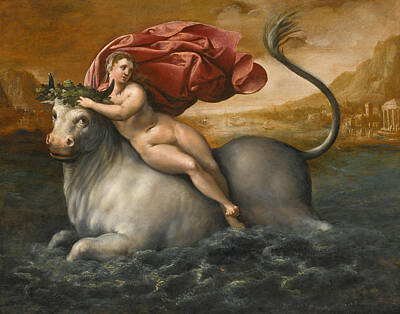Gillis Congnet
The Abduction of Europa
Mary Magdalene
Salome with the head of John the Baptist
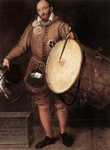
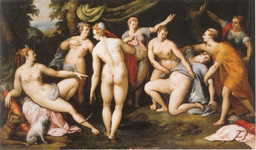
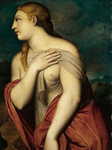
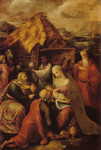


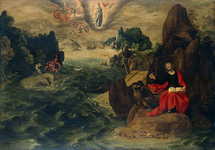
Landscape with St John the Evangelist at Patmos
Attributed to Gillis Coignet
Leda and the swan
Fine Art Prints | Greeting Cards | Phone Cases | Lifestyle | Face Masks | Men's , Women' Apparel | Home Decor | jigsaw puzzles | Notebooks | Tapestries | ...
Gillis Coignet, Congnet or Quiniet (c. 1542 – 1599) was a Flemish Renaissance painter, who was strongly influenced by the Italian style. He painted historical and mythological subjects of an easel size, but was more successful in landscapes, in candlelight subjects, and moonlight. He was a Lutheran, which probably influenced his moves from Antwerp to Amsterdam and then Hamburg. He spent most of the 1560s in Italy.
Biography
Antwerp
Gillis was born in Antwerp, the son of Gillis sr., a scientific instrument maker, and Brigitta Anthonis.[1] In the certification book of the city of Antwerp of 1579 he claimed to be 37 years old, in that of 1586 he claimed to be 43,[2] thus he was born ca. 1542 and, if his statements are correct, he was born between April and September of that year. He had the misfortune to be born with a large hairy mole in his face, hence his nickname Gillis met de Vlek (Gillis with the Spot). According to the Guildbooks of the Guild of St. Luke, Gillis was apprenticed to Lambrecht Wenslyns. Van Mander's claim that he stayed with the art dealer Anthony Palerme for some time is correct. The latter testified in 1586 that Gillis had been boarding with him when his parents were still alive (i.e. before 1562).[3] In 1561 Gillis was admitted to the Guild of St. Luke as a Master.
Italy
In the second half of the 1560s he journeyed through Italy, where he visited inter al. Florence, Rome, Naples and Sicily. According to the Florentine Accademio del Disegno, Giulio Cognietta fiamingo P(ictor) was present at their meeting of 16 January 1568.[4] In Terni (Umbria) he worked with a painter called Stello on frescoes and an altar in fresco style. According to Van Mander, Stello was Flemish, Nicole Dacos identifies this Stello as a member of the family of painters Stellaert from Mechelen.[5] Both painters are mentioned in a document as members of a group of decorators who embellished the salon of the Villa d'Este under the supervision of Frederico Zuccaro,[5] they also worked on an embossed grotesque in the Palazzo Giocosi.[5] Apparently Gillis also worked for Francesco de' Medici.[6]
Return to Antwerp
After 1570 he returned to Antwerp where he employed a number of apprentices.[7] In July 1571 the painter Willem vanden Bosch wrote to the Duke of Alba that Gillis would like to enter the service of the Duke.[8]
Gillis was married to Magdalena de Kempeneer, but it is uncertain whether he married her before or after his Italian journey. They had only one child Juliana (?- about 1616).[9]
At the end of the 1570s they lived in the house De hove van de Jonge Voetboog, which belonged to the Guild of St-Joris (St. George).[10] In March 1580 he and his wife bought the lifelong usufruct of the house for 750 guilders on the condition that the Guild members could use the bowling green at any time. The house stood in the Schuttershofstraat and had a rent value of 40 guilders.[11]
For the monthly quotisation, a special tax levied to pay for defence against the Spaniards, Gillis Coignet's family was taxed at 2 guilders 10 stivers indicating that Gillis enjoyed affluent circumstances. At that time Gillis was considered to be a Martinist (i.e. a Lutheran).[12]
In 1581 Gillis became a member of the Armenbus of the Guild of St. Luke. The Armenbus was founded in 1538, following the example of other trades, and was formed to support the members who by sickness or accident were unable to support their families or whose relatives were too poor to pay for the burial service. After joining the Armenbus there was a waiting period before the benefits could be enjoyed. The Armenbus was chaired by two 'busmeesters', in the first year one was 'medebusmeester' (deputy chairman) and in the succeeding year became 'hoofdbusmeester' (chairman).[13] In 1582, one year after joining the Armenbus Gillis became mede-busmeester,[14] in the following year he became hoofdbusmeester with Philip Galle, the engraver, as medebusmeester.[15] This same year Gillis seems to have persuaded a number of his relatives to become members of the Armenbus, including his brothers the physician Jacob and the court mathematician Michiel together with their wives.[16]
Annunciation, 1584
In 1584 Gillis became Dean of the Guild of St. Luke,[17] a post he would continue to perform during and shortly after the siege by the Spaniards. It therefore can be no surprise that doubts about his religion and his behaviour were raised after the Reconciliation. In 1586, however, Anthony Palerme and Jan van de Kerckhove testified that Gillis had behaved himself "with all modesty and peacefulness".[18] Gillis also testified on behalf of other Guild members, e.g. he testified together with Philip Galle and Gerard de Jode that Marten van Valckenborch and his son-in-law Henrick van Steenwijck were citizens of the town.[19]
It appears that Gillis had no intention to leave the city at that time. He paid his dues to the Guild for 1585-86, and on 3 October 1585 he and Philips Galle, the new Dean, examined the accounts of the Guild. Apparently some difficulties arose, a dispute occurred and a conciliatory meeting with the elders (= previous deans) was held on 26 October 1585. His last appearance in the Guildbooks dates back to Ascension Day 1586, when it became apparent that the accounts he and Ambrosius Vrancken had drawn up did not balance.[20]
In the Spring of 1586 Gillis sold the usufruct of the house to Hendrik Jennen.[21] A note from Philip Galle, written after 4 September 1586, makes clear that Gillis had left town.[22]
Amsterdam
Gillis went to Amsterdam, where he became a citizen in 1589. According to van Mander he was a successful painter in Amsterdam, and influenced the art scene in that city considerably.[23] Van Mander also asserts that it was Gillis Coignet who persuaded Hans Vredeman de Vries to come to Amsterdam.[24]
On 6 April 1588 he was a representative for the Lutheran community of Amsterdam.[25] On 15 March 1590 he had a dispute with the Calvinist painter Adriaan Conflans.[26] It is not clear whether their religious beliefs had anything to do with this dispute, but it is not impossible as the relations between Lutherans and Calvinists in the Amsterdam at that time were very bad indeed.
Hamburg
About 1593-94 Gillis went to Hamburg, "because of his religion or something else" according to van Mander,[27] and he is last mentioned in Amsterdam on 21 January 1593, when he was a witness at a baptism.[28] His painting Lottery on the Rusland, painted in Amsterdam, is dated May 1593, while The Last Supper was painted in Hamburg dated 1595. Gillis died in Hamburg on 27 October 1599 and was buried in the Jacobskirche.[29]
His daughter Juliana married Philips van der Veken; she died before or during 1616. Her husband tried, as the executor of her will, to recover the money which her father had lent to the city of Antwerp.[30]
Paintings
Gillis' paintings betray the influence of the Venetian school and more in particular that of Titian and Tintoretto. The quick dashes and the diversity of the tonality reminds one of the later work of Titian. This is very clear in the painting Venus and Amor (1579). His Portrait of Pierson de la Hues demonstrates very good observational skills. According to Van Mander Gillis Coignet painted many night scenes, in which he employed goldleaf to highlight torches and candles.[31] This is illustrated by Lottery on the Rusland (1593) which is ascribed to Gillis Coignet.
His Lutheran conviction also shows in his paintings, for instance in his Last Judgment. Figures which are usual in such paintings, such as Maria and St. John are omitted and replaced by allegorical figures such as Pax with the Lamb and Justice, with the Mosaic Law. To the left of this large painting one can find a depiction of the mortal sins, while to the right one finds the donor surrounded by the works of charity. Many of his paintings however are only known to us through engravings made by his contemporaries like R. and J. Sadeler, P. de Jode and P. Galle. It is also necessary to mention that, according to Van Mander, he sold copies made by his pupils under his own name.
'Mary Magdalene, 1575
Saint Peter, 1585
Pierson La Hues, 1581, now at the Royal Museum of Fine Arts, Antwerp
Adoration of the Kings, 1584
Autographed
Last Judgment (also: Allegory of the charitas christiana), 1572, oil on canvas, 570 x 200 cm, private collection.
Fire at the Antwerp Citadel, 1577, oil on canvas, 80 x 120 cm, private collection.
Amor and Venus, 1579, copy after Titian, oak panel, 139 x 96 cm, Hessisches Landesmuseum, Kassel, lost during the Second World War.
Saint George, 1581, panel, 193 x 225 cm, Royal Museum of Fine Arts, Antwerp.
Pierson la Hues drummer boy of the Old Handbow Guild (Oude Handbooggilde), 1581, panel, 170 x 133 cm, Royal Museum of Fine Arts, Antwerp
Queen Dido is presented with a town plan, 1583, panel, 175 x 253 cm, Museum Vleeshuis, Antwerpen.
Anunciation, 1584, Co-cathedral of Santa María de la Redonda, Logroño, Spain
Epiphany, 1584, Logroño, as previous
St Peter, 1584, Logroño, as previous
Reclining lady with Cupid and gentleman, sitting on a drum, playing the harpsichord (also: Mars and Venus or Venus and Music), 1590, oil on canvas, 145 x 220 cm, Franke, Leipzig, 1933.
Lottery in front of the Dolhius at the Rusland, 1593, panel, 113 x 203,5 cm, Amsterdams Historisch Museum, Amsterdam.
Last Supper, (sketch), 1594, panel, Ducal Museum, Gotha
Last Supper, 1595, oil on canvas, 163 x 333 cm, St-Petrikirche, Hamburg.
Vanitas, 1595, oil on canvas, 200 x 159 cm, Musée Baron Gérard, Bayeux.
Mars and Venus, 1598, oil on canvas, 113 x 182 cm, Musée du Présidial, Saintes, Charente-Maritime
Danae, undated, panel, 116,5 x 168,5, Christie's, New York.
Petri-Altar (also Grabower-Altar), by Bertram van Minden, of which Gillis overpainted the wings. During the nineteenth century restoration the painting by Gillis Coignet was removed. They depicted Resurrection and Pentecost. Hamburger Kunsthalle, Hamburg.
Saters during Dionysius' feast, undated, Mak van der Waay, Amsterdam 1972.
Time reveals Truth, undated, oil on canvas, 170 x 190 cm, Fernand Niedecker,1939.
Undated and ascribed to Gillis Coignet
Devil's wizardry, oil on canvas, 140 x 105 cm, Pinacoteca Vaticana, Vaticaanstad.
Plato's cave, 174 x 131 cm, panel, Musée de la Chartreuse, Douai.
Diana discovers Callisto's betrayal, oil on canvas, 175 x 103 cm, Szépmüvéstzeti Múzeum, Budapest.
Sine Cerere et Baccho friget Venus, oil on canvas, 242 x 166 cm, Statens Konstmuseer, Stockholm.
Balthazars Feast, panel, 97 x 72,5 cm, Musée d'Arras, Ancienne Abbaye de Saint Vaast, Arras.
Judith shows Holofernes's head to the inhabitants of Bethulia, panel, 62,5 x 149 cm, Musée des Beaux-Arts, Caen.
The Gods on the Olympos, 93 x 130,5 cm, London, Trafalgar Galleries.
Die Befreiung der Andromeda, oil on canvas, 214 x 124 cm, also ascribed to Mathias Gundelach, Lempertz, Keulen, 3 October 1928.
Der Hafen von Venedig, Lempertz, Cologne, 21–24 April 1937.
Landscape with Paris' Judgment, private collection, Taiwan.
Diana and her nimphs surprised by Actaeon, 75 x 96,5 cm, also ascribed to A. Van Blocklandt, Christie's, London, 22 July 1983.
An allegory; Spain as protector of religion, the liberal arts, science and agriculture in the Netherlands, oil on canvas, 31 x 45,5 cm; also ascribed to Hendrick de Clerck, Sotheby's, 12 December 1984.
Cleopatra, oil on canvas, 116 x 102 cm, Lenormand, Paris, 11 December 1991 (24).
Venus and Cupid, 82 x 66,5 cm, also ascribed to Hendrik Goltzius, Christie's, London, 29 October 1993.
Psyche and Cupid, 127,7 x 174,7 cm, oil on canvas, also ascribed to Bartholomeus Spranger's circle, Christie's, New York, 12 January 1996.
Diana and Actaeon, 146 x 186,5 cm, oil on canvas, also ascribed to Jacob de Backer, Sotheby's, London, 11 December 1996.
Ceiling paintings in the Palazzo Giocosi, Terni: Giunone e le nimfe and Perseo e Andromeda.
Grotesques in the Villa d'Este .
Etchings after paintings by Gillis Coignet
P. de Jode, Aristotle and Phyllis.
P. Galle, The four Eras of Mankind, 1573, four copper etchings, 31,5 x 24,7 cm, diameter 24,5 cm.
J. Matham, Moses lets the rock spill water.
J. Muller, Last Supper, 3 plates, 44,5 x 93,3 cm.
J. Sadeler I, John the Baptist, kneeling, 24,5 x 20,1 cm.
J. Sadeler I, Kneeling St Peter, 20,2 x 15 cm.
R. Sadeler I, Cleopatra's Death, 19,8 x 25,7 cm (25).
R. Sadeler I, Venus, Bacchus and Ceres, 19,9 x 24,6 cm (20).
J. Wiercx, The Three christian Charities.
s.n., Orisgonta Tebessa, Gideon.
s.n., Susanna in bath.
Sources
Briels, J.G.C.A. (1976). De Zuidnederlandse immigratie in Amsterdam en Haarlem omstreeks 1572-1630 : met een keuze van archivalische gegevens betreffende de kunstschilders. Fibula.
Meskens, Ad (1998). Familia Universalis: Coignet. Royal Museum of Fine Arts, Antwerp.
Miedema, Hessel (1994–1997). The lives of the illustrious Netherlandish and German painters, from the first edition of the Schilder-boeck (1603-1604), preceded by the lineage, circumstances and place of birth, life and ..., from the second edition of the Schilder-boeck (1616-1618).
Miedema, Hessel (1995). "Nog een schilderij van Gillis Coignet: Judith toont het hoofd van Holofernes aan de inwoners van Bethulië,". Oud Holland. pp. 143–151.
Rombouts, Philip Felix; van Lerius, Theodoor (1874). De liggeren en andere historische archieven der Antwerpsche Sint Lucasgilde. Baggerman.
van der Stock, Jan (1993). Antwerpen: verhaal van een metropool. Snoeck-Ducaju & zoon.
van Mander, Carel (1943). Het Schilder-boek: het leven der doorluchtige Nederlandsche en Hoogduitsche schilders, hertaald door A.F. Mirande en G.S. Overdiep naar de tweede druk 1618. Wereldbibliotheek.
van Hemeldonck, Godelieve (1998). Repertorium der Belgische goud- en zilversmeden (manuscript copy). City Archives Antwerp.
References
G. van Hemeldonck (1998), no.427. See also SAA (City Archives Antwerp) Pk3573, no pagenumbers. Detailed information about the Coignet family in A. Meskens(1998).
SAA Cert40 (1579), f24; Cert47(1586), f505-506.
SAA Pk3573; SR386, f93v.
J.A.F. Orbaan, Italiaansche gegevens, Oud Holland, vol. 21, 1903, pp.161-164, p.163.
Dacos (ed.), Nicole (1995). Fiamminghi a Roma. Snoeck-Ducaju. p. 157. ISBN 90-534916-5-1.
H. Miedema (1998).
According to the guildbooks (P. Rombouts & T. van Lerius (1874) I) these were Simon Utens (p.243), Jaspar van Doorne (p.256) and Robert Keuls (p.289). According to Karel van Mander the Haarlem painter Cornelis Cornelisz. also worked in Gillis' workshop, presumably towards the end of the 1570s.
Documentos del Archivo de la Casa de Alba, Madrid, 1891, p.106-107.
P. Rombouts & T. van Lerius (1874) I, p.184. It is not known when or where she was born. Her name does not appear in the baptismal records of churches in Antwerp or Amsterdam. This would suggest that she was either born on the way to Amsterdam (about 1586) or in Hamburg (after 1595).
SAA Cert40, f24, in which Gillis claims to be living in de hove van de Jonge Voetboog.
SAA SR360 f1v; Pk 3359
SAA Fiches VAN ROEY; SAA R2422, f16r; R2434, f15r; R2440, f68r.
C. van de Velde in J. van der Stock (1993), p.251.
Artesis University College Dept B Bib 243(4), f28v.
Artesis University College Dept B Bib 243(4), f29r.
Ad Meskens, Practical mathematics in a commercial metropolis: Mathematical life in late 16th century Antwerp, Springer Science & Business Media, 12 Mar 2013, p. 16
P. Rombouts & T. van Lerius, (1874) I, p.184.
[Dat hij] "hem gedraghen [had] in alle modestie ende vreedtsaemheyt". SAA Pk3573; SR386, f93v.
G. van Hemeldonck (1998), nos. 428 and 479; also SAA Cert47, f505-506.
P. Rombouts & T. van Lerius (1874) I, pp.315-316.
SAA SR387, f11v.
P. Rombouts & T. van Lerius (1874) I, p.317. According to F.J. van den Branden he left Antwerp on 23 September 1586 (SAA Pk3573).
C. van Mander (1943), p.400.
C. van Mander (1943), p.428.
J.G.C.A. Briels (1976), p.17; H. Miedema(1995), p.149.
H. Miedema(1995), p.149-150.
His painting Vanity: allegory is signed 'G. Coingnet inve. et fec. in Hamborch 1595'.
J.G.C.A. Briels (1976, p.81; H. Miedema (1995), p.150.
P. Rombouts & T. van Lerius (1874) I., p.184.
SAA N2405, f107r-v.
C. VAN MANDER (1943) , p.153.
This article incorporates text from the article "CONGNET, Gilles" in Bryan's Dictionary of Painters and Engravers by Michael Bryan, edited by Robert Edmund Graves and Sir Walter Armstrong, an 1886–1889 publication now in the public domain.
----
Fine Art Prints | Greeting Cards | Phone Cases | Lifestyle | Face Masks | Men's , Women' Apparel | Home Decor | jigsaw puzzles | Notebooks | Tapestries | ...
----
Artist
A - B - C - D - E - F - G - H - I - J - K - L - M -
N - O - P - Q - R - S - T - U - V - W - X - Y - Z
Retrieved from "http://en.wikipedia.org/"
All text is available under the terms of the GNU Free Documentation License





